The Lincoln penny has a rich history that makes it one of the most collectible U.S. coins. Remarkably, despite being over a century old, many Lincoln cents — including those from 1958 — can still be found in circulation today.
The value of a 1958 Wheat penny depends on several factors, such as the coin’s condition, any visible damage, wear signs, and its availability on the market.
Here’s a quick breakdown of the 1958 Wheat Penny Value Chart:
| Condition | 1958 No Mint Mark Penny | 1958 D Penny | 1958 DDO Penny |
|---|---|---|---|
| Fine | $0.06 | $0.06 | / |
| Very Fine | $0.12 | $0.12 | / |
| Extra Fine | $0.14 | $0.14 | / |
| AU | $0.18 | $0.18 | / |
| MS 60 | $0.35 | $0.35 | $142,623 |
| MS 63 | $1.20 | $1.20 | $232,795 |
| PR 63 | $9.69 | / | / |
History of the 1958 Wheat Penny
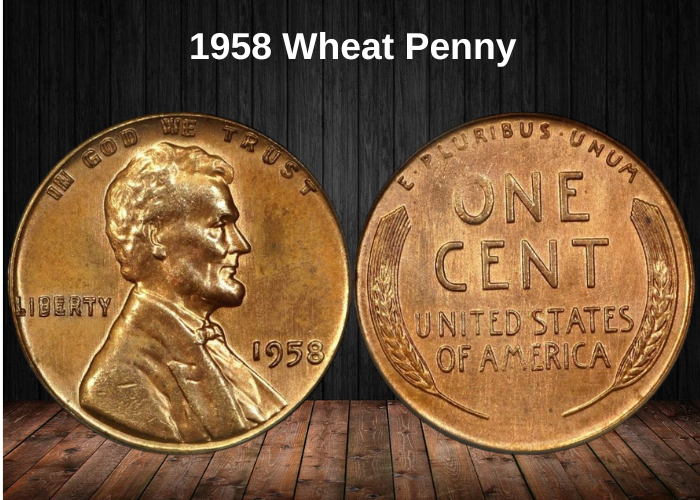
The Lincoln penny was first minted in 1909 to commemorate the 100th anniversary of Abraham Lincoln’s birth. It holds a special place in U.S. Mint history as the first American coin to feature a real person’s portrait, moving away from the tradition of depicting symbolic figures like Lady Liberty or imaginary Indian chiefs.
The obverse of the penny showcased Lincoln’s iconic profile, while the reverse featured two wheat stalks, earning it the nickname “Wheat Penny.” This simple yet meaningful design paid tribute to America’s agricultural heritage.
The Lincoln Wheat pennies were minted from 1909 to 1958, with the design crafted by sculptor Victor David Brenner. The earliest coins prominently displayed his initials, VDB, between the wheat stalks at the bottom rim. However, the U.S. Mint quickly removed the initials, reportedly because they were too large and conspicuous, though several theories about the decision exist.
1958 Wheat Penny Mintage Figures
| Location | Year | Mintage |
|---|---|---|
| Philadelphia | 1958 No Mint Mark Penny | 252,525,000 |
| Philadelphia | 1958 Penny (Proof) | 875,652 |
| Denver | 1958-D Penny | 800,953,300 |
| Total | / | 1,054,353,952 |
Over time, the Lincoln penny has undergone several design and composition changes:
- In 1959, to celebrate the 150th anniversary of Lincoln’s birth, the U.S. Mint replaced the wheat reverse with the Lincoln Memorial design by Frank Gasparro.
- Due to fluctuations in copper prices, the coin’s composition also changed. Rising copper values prompted the Mint to switch from a 95% copper composition to one of 97.5% zinc with a thin copper coating.
These changes reflect not only historical milestones but also economic considerations that have shaped the penny over the decades.
Features of the 1958 Wheat Penny
The obverse of the 1958 Wheat Penny
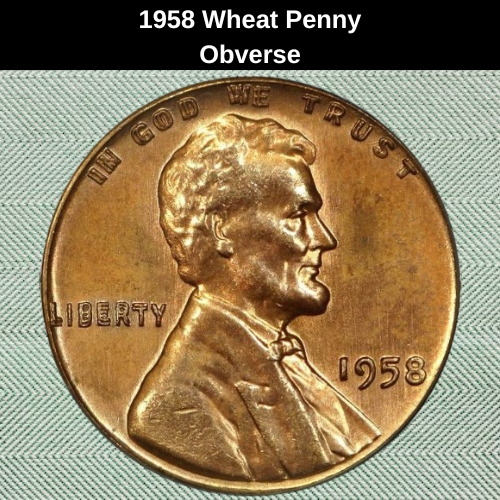
One of the most notable aspects of the 1958 Wheat penny is its simple yet dignified design. The bust of President Abraham Lincoln dominates the obverse, centered prominently and depicted in profile, facing right. He is shown wearing an elegant suit characteristic of the 19th century, adding a touch of historical authenticity.
Surrounding Lincoln’s portrait are several important inscriptions:
- “IN GOD WE TRUST” appears along the top rim, directly above the President’s head.
- “LIBERTY” is positioned to the left, behind Lincoln’s shoulder.
- The minting year, 1958, is displayed on the right, near the bottom rim.
- If present, the mint mark (such as D for Denver) is located just above the minting year.
The overall layout emphasizes Lincoln’s legacy with a clean, respectful design that continues to be admired by collectors and history enthusiasts alike.
The reverse of the 1958 Wheat Penny
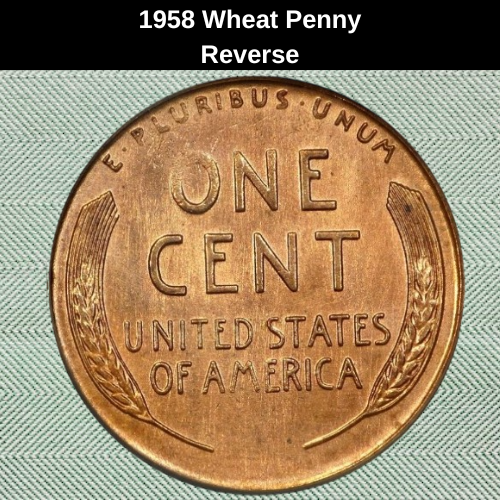
The reverse of the 1958 Wheat penny features a clean and classic design centered around its denomination:
- The words “ONE CENT” dominate the center of the coin.
- Just below the denomination is the inscription “UNITED STATES OF AMERICA.”
- Along the upper rim, you’ll find the Latin motto “E PLURIBUS UNUM.”
- On either side of the central inscriptions, two wheat stalks gracefully curve along the rim, symbolizing the nation’s agricultural heritage.
This simple yet symbolic design remained consistent throughout the Wheat penny series until its redesign in 1959.
1958 Wheat Penny Details
| Feature | Specification |
|---|---|
| Face Value | One Cent ($0.01) |
| Shape | Round |
| Composition | 95% Copper, 5% Tin and Zinc Alloy |
| Diameter | 0.75 inches (19.05 mm) |
| Weight | 0.11 ounces (3.11 grams) |
| Edge | Plain |
| Thickness | 0.06 inches (1.52 mm) |
Note:
The 1958 Wheat penny shares its physical characteristics with pennies from previous years. Despite minor fluctuations in copper prices, the U.S. Mint maintained the 95% copper and 5% tin and zinc composition until later changes in the 1980s.
1958 Wheat Penny Grading
Grading is essential to determining a 1958 Wheat Penny’s value. During this process, experts carefully evaluate the coin based on its:
- Appearance
- Condition and preservation
- Signs of wear
- Visible damage or breakage
- Possible minting errors
A key indicator of a penny’s quality is the presence of original luster on the coin’s surface. Coins that retain their full mint luster are considered to be in Mint State and typically command higher values.
Below is a basic grading scale for the 1958 Wheat Penny:
| Grade Number | Grade Description |
|---|---|
| 1 | Basal State-1 |
| 2 | Fair |
| 3 | Very Fair |
| 4, 5, 6 | Good |
| 7, 8, 10 | Very Good |
| 12, 15 | Fine |
| 20, 30 | Very Fine |
| 40 | Extremely Fine |
| 50 | About Uncirculated |
| 60 | Mint State |
| 65 | Mint State (Gem Quality) |
| 70 | Mint State (Perfect) |
📌 Tip: Always refer to a detailed coin grading guide when evaluating your 1958 Wheat Penny. Accurate grading is crucial for correctly determining your coin’s market value.
1958 Wheat Penny Value Guides
1958 No mint mark Wheat Penny value

In 1958, the Philadelphia Mint struck an impressive 252,525,000 wheat pennies without a mint mark. Due to this high mintage, these coins remain easily available on the market today, resulting in very affordable prices.
- Circulated examples:
These coins typically hold low value, ranging from $0.02 to $0.07 depending on their condition. - Uncirculated (Mint State) examples:
- MS60 to MS64: Priced between $0.50 and $2.50.
- MS65 Brown: About $5.
- MS66 Brown: Around $12.50.
- MS67 Brown: The highest for brown examples at approximately $35.
- Red-Brown examples:
These coins are slightly more valuable:- Value ranges from $0.35 to $45, depending on the grade.
- Red examples:
Red coins are the most desirable and command the highest premiums:- MS63: Around $1.50
- MS64: Approximately $2.50
- MS65: About $5
- MS66: Close to $12.50
- MS67: Highly sought-after, often selling for up to $335 at auction.
📌 Fun Fact: Red 1958 no-mint mark Wheat Pennies in top condition are especially popular among collectors and can fetch hundreds of dollars when auctioned!
1958 Wheat Penny value (proof)

In addition to regular circulation coins, the Philadelphia Mint produced 875,652 proof pennies in 1958. Although these proofs are collectible, their value typically remains modest compared to other rare proofs.
Here’s a breakdown based on quality and color designation:
- Brown Proofs:
- Value ranges from $0.60 to $10, depending on the grade.
- Red-Brown Proofs:
- PR60 graded pieces start around $5.00.
- PR67 examples can fetch up to $52.
- Red Proofs:
- Typically worth between $1 and $40 based on condition and eye appeal.
- An exceptional PR69 Red penny can command as much as $550!
📌 Tip: When collecting proof pennies, look for coins with strong mirrors and minimal spotting to ensure better resale value.
1958 D Wheat Penny
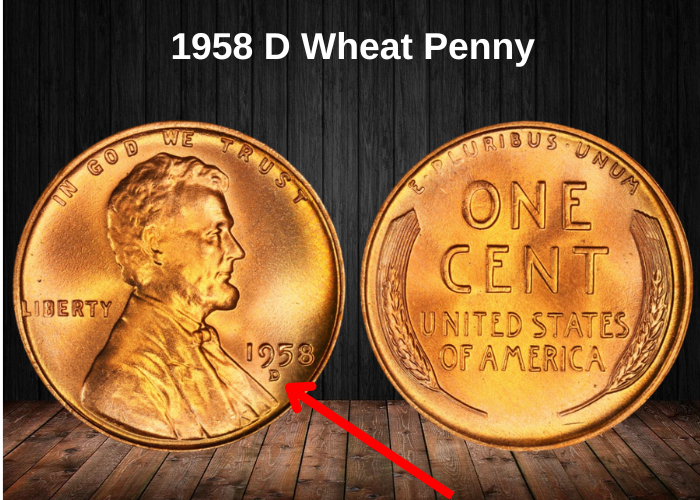
The Denver Mint struck an impressive 800,953,000 wheat pennies in 1958, making the 1958-D Lincoln cents very common. Because of their high mintage, these coins typically have modest values.
Circulated Condition:
- Average circulated examples are worth between $0.02 and $0.06.
Mint State (Uncirculated) Condition:
- MS60 to MS64 grades are priced from $0.50 to $2.50.
As the grade improves, the value rises accordingly:
Brown (BN) Coins:
- MS65 BN: $5
- MS66 BN: $12.50
Red-Brown (RB) Coins:
- MS63 RB: $6.50
- MS64 RB: $10
- MS65 RB: $17.50
- MS66 RB: $25
- MS67 RB: $250
Red (RD) Coins:
- Most red examples cost between $0.55 and $18, depending on the grade and overall eye appeal.
- Top-grade MS67 Red pennies are valued around $250.
📝 Note: Red 1958-D cents are especially desirable among collectors, which helps boost their value slightly compared to brown and red-brown examples.
Rare 1958 Wheat Penny Errors List
DDO
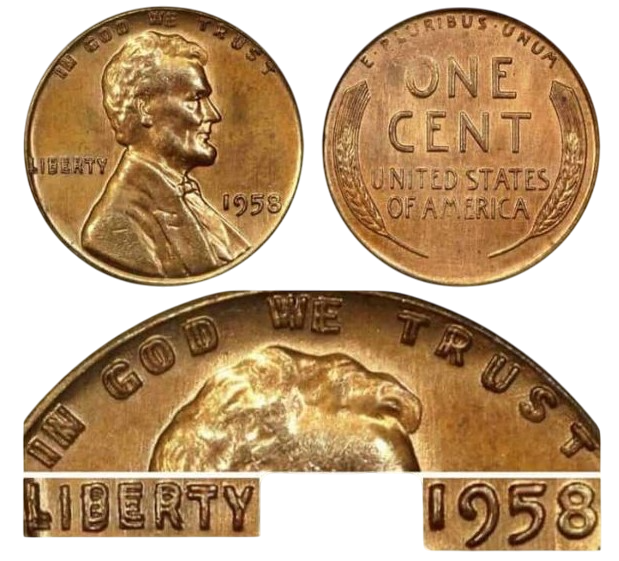
The Doubled Die Obverse (DDO) is one of the most famous and sought-after errors among Lincoln pennies. However, the 1958 DDO penny is exceptionally rare, with only three known specimens in existence.
In these rare examples, the doubling is clearly visible on the inscriptions:
- LIBERTY
- IN GOD WE TRUST
- The minting date (1958)
Value and Auction Records:
- A 1958 red DDO penny fetched an astonishing $336,000 at auction in 2018.
- Even more impressively, a red 1958 DDO penny graded MS66 was sold for an incredible $1.136 million at an auction in January 2023.
🏆 Fun Fact: This sale marked the first time in history that a Lincoln cent sold for over $1 million, setting a new record in numismatics!
1958 Off-Center Error Penny
An off-center error occurs when the die that strikes the coin is not properly centered, causing the design to be shifted to one side. As a result, part of the coin’s design is missing.
Key Features:
- Missing Design: The deficiency can range from 5% to 95% of the design being absent, depending on the severity of the misalignment.
Value:
The value of an off-center penny depends on how much of the design is missing. These coins are generally priced between $5 and $100, with the exact amount determined by the percentage of the design that is missing.
For example, a 1958 penny with a 20% off-center strike sold for $30 at an auction.
Clipped planchet
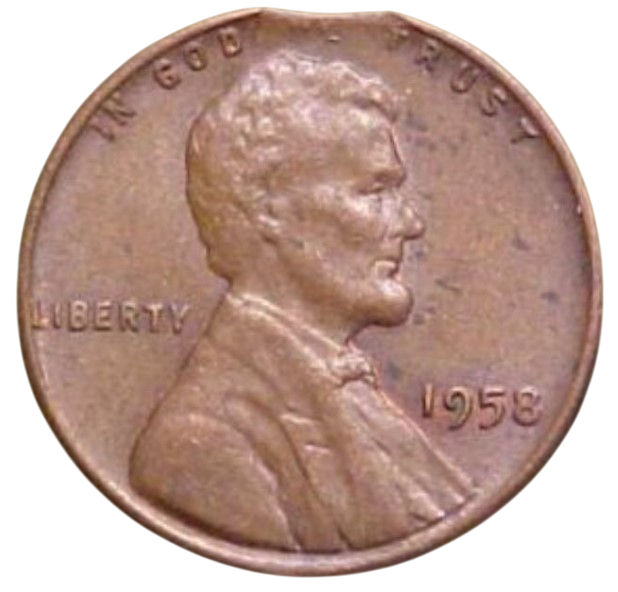
An incorrectly cut planchet error occurs when the planchet (the metal disk before striking) is not properly cut to size. As a result, the edge of the coin may be missing part of its design or appear uneven.
Key Features:
- Missing Edge: The error typically causes the edge part of the coin to be missing, leading to a coin that looks incomplete or misaligned.
Value:
Coins with this error generally have a modest value and can be found priced between $2 and $6, depending on the extent of the error and its condition.
1958 Penny Struck on a Silver Dime Planchet Error
A penny struck on a silver dime planchet is one of the most fascinating and valuable coin errors. This occurs when a penny planchet (the metal disk used to make pennies) is mistakenly replaced by a silver dime planchet, which is slightly smaller than the penny planchet. As a result, a penny design is struck on a dime-sized coin.
Key Features:
- Size Discrepancy: Since the dime planchet is smaller, the penny struck on it will appear smaller and may have a slightly different thickness or weight compared to regular pennies.
- Composition: The dime planchet is typically made of 90% silver, while the penny is made of copper, so this error results in a coin with an unusual composition.
Value:
These coins are extremely rare and highly sought after by collectors. A 1958 penny struck on a silver dime planchet can fetch several thousand dollars, depending on its condition. For example, a well-preserved coin could sell for anywhere between $2,000 to $5,000 or more at auctions, depending on its grade and rarity.
Penny overstruck on Cuba Centavo
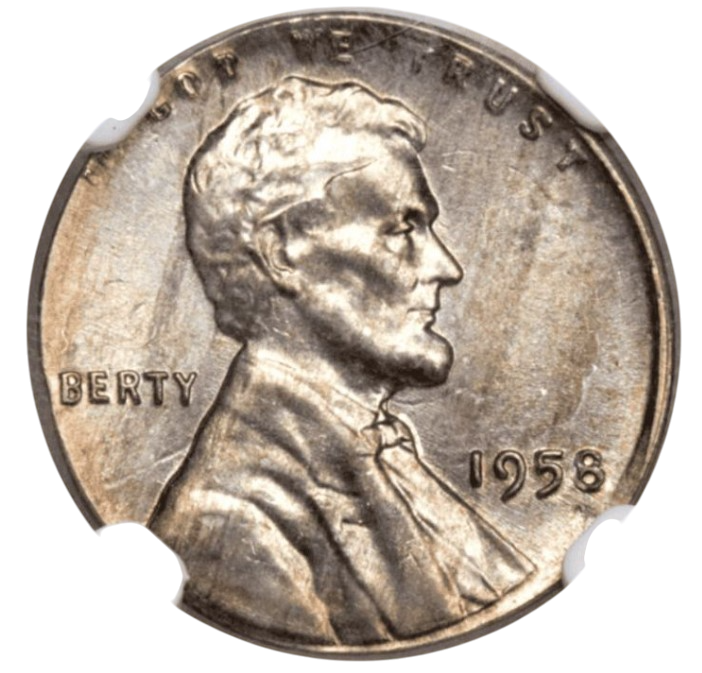
When a penny is struck on a dime planchet, it may appear slightly smaller than the standard size. Since a dime planchet is smaller in diameter and thinner than the usual penny planchet, it can result in a diminished design with some letters or features being cut off from the coin’s edge.
Key Characteristics:
- Smaller Size: The coin will have a dime-sized appearance, usually measuring about 17.91 mm in diameter (versus the standard penny’s 19.05 mm).
- Missing Letters: A significant portion of the letters (such as those in the phrase “LIBERTY” or the minting year) may be cut off due to the smaller size and improper planchet.
- Weight Discrepancy: These coins often weigh around 0.09 ounces (2.45 grams) instead of the standard 0.11 ounces (3.11 grams) for a regular penny.
- Composition Difference: The error coin will be made of silver (from the dime planchet), not copper, giving it a distinctive metallic appearance.
Value:
These error coins are highly sought after by collectors, especially if they are in good condition. Because of the rarity of the mistake and the differentiation in weight and design, you can expect to sell a 1958 penny struck on a dime planchet for a premium price. Depending on its condition and the extent of the error, these coins can range from a few thousand dollars, with some rare specimens fetching upwards of $5,000 to $10,000 or more.
Selling Potential:
- Lightly worn or circulated examples: Can still fetch a couple of thousand dollars.
- Mint-state or well-preserved specimens: Can be worth much more, potentially in the $5,000+ range.
If you ever come across one of these rare errors, it’s important to have it graded by a professional numismatic service, as its value can significantly increase with proper authentication and grading.
Where to sell your penny?
Now that you know the value of your penny, you might be wondering where to sell it. Don’t worry: here’s a guide to some of the best online platforms where you can easily sell your coins, along with their advantages and disadvantages.
Discover the best platforms for selling coins online (pros and cons).
FAQ about the 1958 Wheat Penny
1. Why is the 1958 Wheat Penny significant in U.S. coinage history?
The 1958 Wheat Penny is historically significant because it is the final year that the Wheat reverse design was used on U.S. pennies. Starting in 1959, the U.S. Mint transitioned to the Lincoln Memorial reverse design, marking the end of nearly 50 years of the Wheat motif on the back of pennies. The 1958 penny therefore represents the conclusion of the Wheat series and is highly collectible for this reason.
2. What is the metal composition of the 1958 Wheat Penny?
The 1958 Wheat Penny is made of:
- 95% copper
- 5% zinc
This composition was standard for U.S. pennies minted from 1909 to 1942 and from 1944 to 1958. The copper content gives the penny its reddish-brown appearance, which is a hallmark of Wheat pennies.
3. How many 1958 Wheat Pennies were minted?
The 1958 Wheat Penny was minted in the following quantities:
- Philadelphia (no mintmark): 1,144,518,000
- Denver (D): 434,000,000
- San Francisco (S): 28,175,000
With a total mintage of over 1.6 billion pennies, the 1958 Wheat Penny is relatively common. However, its status as the final year of the Wheat reverse design makes it particularly attractive to collectors.
4. What is the value of a 1958 Wheat Penny today?
The value of a 1958 Wheat Penny depends on its condition:
- Circulated coins: Generally worth $0.05 to $0.25 in typical circulated condition.
- Uncirculated coins: Coins graded MS-63 or MS-64 are typically worth around $1 to $5.
- High-grade uncirculated coins: Coins graded MS-65 or higher can be worth anywhere from $10 to $25.
- Proof coins: The 1958 proof penny (minted in San Francisco) is typically worth between $5 and $20, depending on the grade.
Despite its relatively high mintage, the 1958 Wheat Penny is still highly collectible due to its status as the last year of the Wheat reverse design.
5. Are there any notable error varieties in the 1958 Wheat Penny?
While the 1958 Wheat Penny doesn’t have as many famous error varieties as some other years, there are still some minor errors that can add value:
- Double Die Obverse (DDO): Like other years, some 1958 pennies exhibit doubled die errors, most notably on the “LIBERTY” and “IN GOD WE TRUST” inscriptions on the obverse. This happens when the die strikes the coin multiple times, creating a doubling effect.
- Off-center strikes: Some coins from the 1958 mintage were struck off-center, creating an incomplete or misaligned design. These are generally more valuable due to their rarity.
- Die cracks and cud marks: Some 1958 pennies show die cracks or cud marks (raised areas caused by damage to the die). These errors can make the coin more interesting to collectors and increase its value.
While these errors are relatively minor, they can still attract interest from numismatists looking for unique pieces.
6. How does the 1958 Wheat Penny compare to other years in the Wheat series?
The 1958 Wheat Penny is significant primarily because it is the last year of the Wheat reverse design, making it more desirable than most other years in the series. While its mintage is high (over 1.6 billion coins), it is still part of the Wheat series, and its historical importance as the final coin in the design makes it a key piece for collectors.
Compared to earlier pennies from the 1930s or 1940s, the 1958 penny is much more common. However, its status as the final year for the Wheat reverse design elevates its collectibility. Additionally, it’s often sought after by collectors who are completing their Wheat series collection.
7. How can I identify a high-grade 1958 Wheat Penny?
To identify a high-grade 1958 Wheat Penny, look for:
- Sharp, crisp details: The Lincoln portrait, wheat stalks, and inscriptions should be clearly defined with no visible wear.
- Minimal to no wear: A high-grade coin will show no wear on Lincoln’s features, the wheat stalks, or the rim. It should appear almost as if it’s never been in circulation.
- Clean surfaces: High-grade coins should have smooth, clean surfaces with no scratches, abrasions, or signs of handling.
- Luster: Uncirculated coins will retain their original luster, giving them a shiny, reflective surface. High-grade coins, such as those graded MS-65 or above, will have very few imperfections and should have a noticeable shine.













































